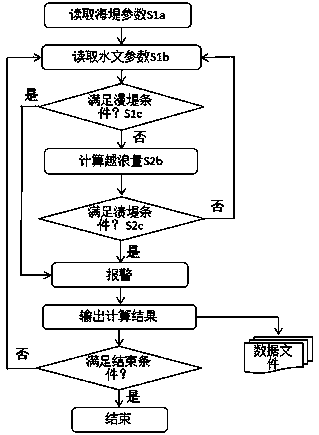Seawall safety real-time assessment method and special device
A special device and seawall technology, applied in the field of seawall safety real-time assessment methods and special devices, can solve problems affecting emergency management of marine disasters and complicated seawall damage mechanisms, so as to improve monitoring and forecasting functions and reduce storm surges Disaster risk, well-designed effects
- Summary
- Abstract
- Description
- Claims
- Application Information
AI Technical Summary
Problems solved by technology
Method used
Image
Examples
Embodiment 1
[0051] A special device for real-time assessment of seawall safety, including at least one alarm device, a computer, a hydrological acquisition device or a storm surge (tide level and wave) forecast model. The alarm device is used for early warning of seawall flooding or breach, and the computer is connected to the The alarm device also receives the hydrological data or storm surge level and wave forecast value of the hydrological acquisition device. The computer can process the received hydrological data or forecast value and decide whether the embankment is overrun or whether the embankment is broken according to the processing results. Control the alarm device.
[0052] The computer is connected to the alarm device and the hydrological collection device respectively, such as Figure 4 As shown, the connection mode between the computer and the alarm device and the hydrological collection device includes a cable connection or a radio connection or an optical coupling connection. ...
Embodiment 2
[0057] Reference Figure 1-2 Take a seawall as an example. The top and back slope protection surface of the seawall is made of square concrete blocks (30cm thick), the height of the wave wall is 1.0m, and the back slope slope is 1:3. According to the obtained tide level and wave Data to determine whether the seawall is breached:
[0058] (1) Obtain the structural parameters of the seawall according to step S2a;
[0059] (2) According to step S2b, use the acquired hydrological parameters and the standard formula to calculate the seawall over-wave volume of 0.27m 3 / (m.s);
[0060] (3) According to step S2c, it can be seen from Table 1a that the threshold of the amount of breaking waves corresponding to a square concrete block (30cm thick) is 0.26m 3 / (ms); From Table 1b, the wave-retaining wall correction coefficient shows that the height of the wave-retaining wall is 1.0m, here is 1.0; from the slope correction coefficient in Table 1c, the slope correction value of 1:3 is 1.0, so th...
Embodiment 3
[0063] The computer program control steps are as follows:
[0064] S1a: Read seawall parameters;
[0065] S1b: read hydrological parameters;
[0066] S1c: Decide whether to meet the flooding conditions, meet the pre-alarm of the control alarm device, and enter the next step if it is not satisfied;
[0067] S2b: Calculate the amount of surging waves;
[0068] S2c: Decide whether to meet the dike breach condition, if it is satisfied, control the alarm device to pre-alarm, do not meet the step of repeating S1b, output the calculation result and store the data file after the alarm; decide whether to meet the end condition, meet the end of the program, and repeat the step S1b . See the schematic diagram image 3 . Its purpose is to accurately obtain parameters such as tide level in front of the embankment, sea embankment over-wave volume, embankment over-wave volume threshold and other parameters according to the hydrological conditions and seawall structure, and then evaluate and predict...
PUM
 Login to View More
Login to View More Abstract
Description
Claims
Application Information
 Login to View More
Login to View More - R&D
- Intellectual Property
- Life Sciences
- Materials
- Tech Scout
- Unparalleled Data Quality
- Higher Quality Content
- 60% Fewer Hallucinations
Browse by: Latest US Patents, China's latest patents, Technical Efficacy Thesaurus, Application Domain, Technology Topic, Popular Technical Reports.
© 2025 PatSnap. All rights reserved.Legal|Privacy policy|Modern Slavery Act Transparency Statement|Sitemap|About US| Contact US: help@patsnap.com



